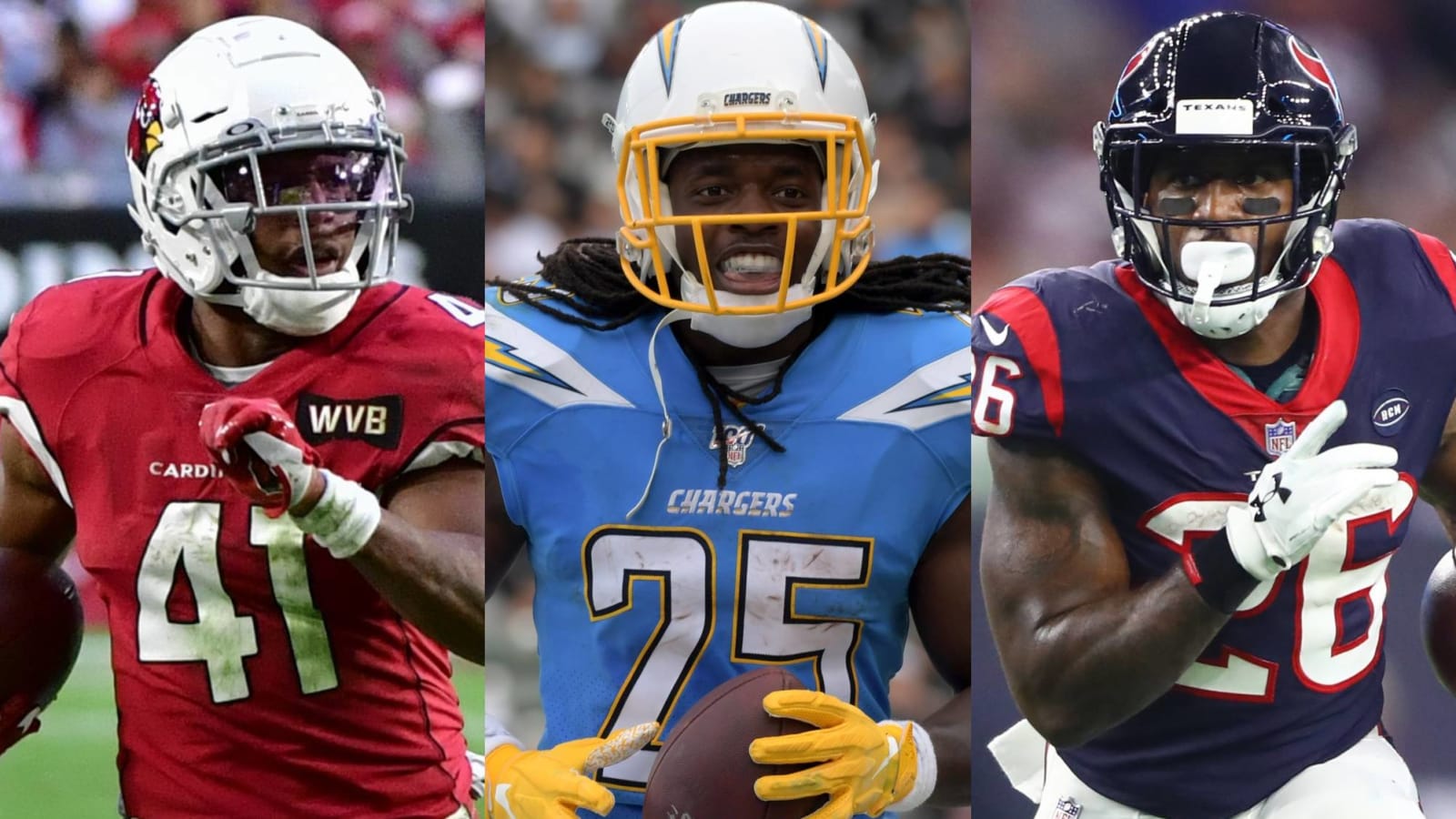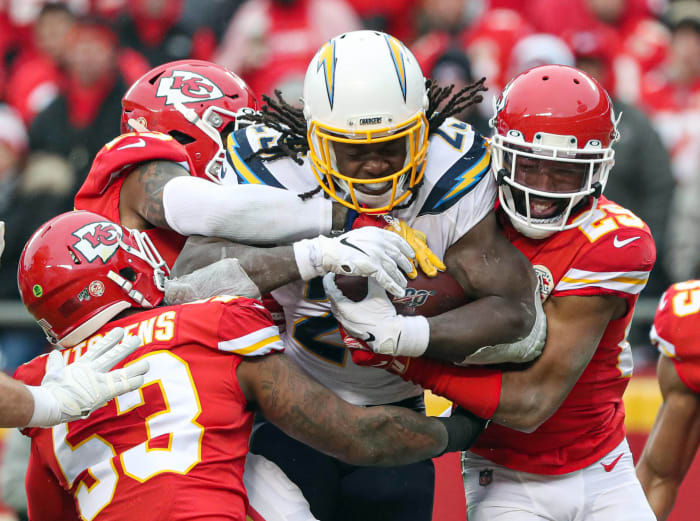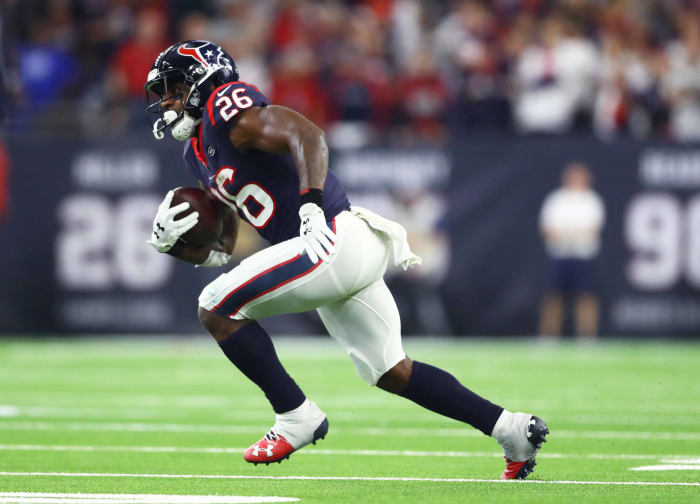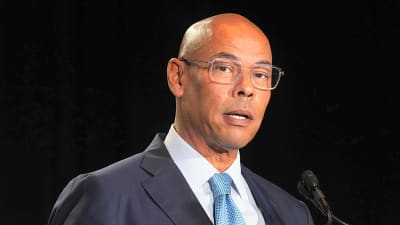
For cost-conscious shoppers, these free-agent RBs could be bargains
NFL free agency will officially begin March 18. Yardbarker's Chris Mueller, Sam Robinson and Michael Nania each offer his most intriguing free-agent running back:
Kenyan Drake: Low mileage, high upside
MUELLER: Running back has never been a more devalued position. Only a select few at the position, typically top-10 picks, get big paydays. The Todd Gurley and David Johnson mega-contracts and their subsequent injury issues have further undercut the market value of the position.
For the players themselves, it’s tough, but for teams looking for value, there are several backs who could help in a big way at a moderate cost. Drake has a higher ceiling than other running back options in free agency. Traded from Miami to Arizona last season, he posted 643 rushing yards and 171 receiving yards for the Cardinals. That kind of production put him on pace for over 1,600 yards from scrimmage for a full season; only six running backs topped that mark in 2019.
What makes Drake a free-agent cipher is his pre-Cardinals career. In 54 games with the Dolphins, he totaled 2,468 yards from scrimmage, an average of just 45.7 per game. Was Drake at fault for those low numbers? His rate statistics were solid -– 4.6 yards per carry in his career and just over eight yards per reception with Miami. But he didn’t get many touches, averaging just over eight per game. The first time in his career he got feature-back touches was the final five games of the 2017 season, and he responded with 594 yards from scrimmage, back-to-back 100-yard rushing performances, and productive work as a receiver. Despite that excellent work, he never again got even 20 touches in a game with the Dolphins.
With the Dolphins last season, Drake's Pro Football Focus offensive grade was 56.9, which would have placed him outside the top 100 at the position if projected over the entire season. However, his 76.8 grade with Arizona would have been good for 15th in the league. Advanced analytics suggest rushing yards are largely a function of offensive line play, but Drake was excellent in one of the crucial, under-discussed aspects of the position. With Arizona, he had 40 snaps as a pass blocker, allowing no sacks and just three hurries, per Pro Football Focus. QB Kyler Murray deserves some credit for those numbers, but Drake was sturdy at blitz pickup when called upon.
Drake is a calculated risk for whichever team signs him. Spotrac put his market value at just over $5.5 million –- for comparison, Christian McCaffrey’s market value is just north of $18 million. He should come at a bargain price on account of having such a small sample of strong play. That said, he has been sparingly used through four years, with just 600 total touches, is a solid pass-catcher and pass-blocker, and has shown tantalizing potential as a runner. In the right situation, he could be a free-agent steal.

Melvin Gordon: He should have plenty in tank
ROBINSON: Several factors will work against Gordon in free agency. His holdout last season went so poorly that not only did Gordon not receive a new contract, but backup Austin Ekeler –- a former undrafted free agent –- outplayed him and the Chargers gave him a long-term deal.
Although Gordon’s resume includes two Pro Bowls, he has finished below 4.0 yards per carry in four of his five NFL seasons. In just one of those seasons, 2017, did Gordon play 16 games. The extensions several of his running back peers signed from 2018-19 considerably raised the position’s salary ceiling but largely burned the teams that authorized those deals. And another strong draft class, at a position with a minimal learning curve, is coming. It is not a good time to be a free-agent running back whose skill set probably tops out at a high-second-tier level.
Gordon is coming off a down contract year but scored at least 12 touchdowns from 2016-18, amassing at least 1,375 scrimmage yards in each, and finished that stretch with a dominant 2018 campaign. The Wisconsin product’s 3.15 yards after contact per attempt that year ranked fifth -– ahead of Ezekiel Elliott and Mark Ingram. Yards-per-carry mediocrity may affect Gordon’s market, but teams should consider the Chargers’ annual trouble fielding competent offensive lines. Here is how Pro Football Focus ranked every line Gordon ran behind: 32nd (2015), 31st (2016), 24th (2017), 30th (2018), 29th (2019). It is borderline miraculous he became a high-end back behind the Bolts’ injury- and talent-depleted fronts.
Some of the big-ticket backs faltering on second contracts will benefit the team that signs Gordon. Because of the failures Gurley, Johnson and Le’Veon Bell experienced after signing their extensions -– all north of $13 million per year –- teams will be justifiably skittish about green-lighting big deals for backs. That will likely force Gordon to sign for well below the rate the Rams, Cardinals and Jets paid the well-compensated trio. The price could drop as low as $7-8M per year. If a team can acquire Gordon at that rate –- on an approximate $200M salary cap -– it would represent strong value. With the 2015 first-round pick also set to sign before some higher-regarded 2017 draftees further reshape the running back market, the team that lands Gordon in March would have a favorable running back contract on its books in an era when that phrase has become oxymoronic.
Gordon, who will turn 27 in April, has logged 1,283 career touches. While that seems high, it is not especially scary. That touch total ranks 19th among 21st-century backs through five seasons. Gordon racked up fewer touches through five years than several backs who were Pro Bowlers on second contracts -– among them Adrian Peterson, LeSean McCoy, Matt Forte and Clinton Portis.
Gordon should have multiple strong seasons left. With veteran running back contracts essentially becoming pay-as-you-go structures after the guarantees stop midway through, Gordon should reward his second team –- which will presumably field a better offensive line compared to the Chargers’ embattled units. Should he land behind a quality O-line, Gordon could make the rare transition from bombing in a contract year to ascending during his second deal.

Lamar Miller: He protects the rock
NANIA: Running back is a difficult position to evaluate. With their primary assignment reliant on the quality of blocking in front of them, it seems unfair for running backs to be judged simply on their rushing production.
Deducing whether or not a back is an effective runner requires hours of delving into their rushing attempts. Is he choosing the correct hole consistently? Does he have an understanding of the playbook? Forget about his missed tackle numbers -- is he doing what is necessary to avoid tacklers in the first place?
With a running back's true rushing performance so difficult to comprehend, I evaluate them using metrics they have much more control over: drops, fumbles, pass protection and receiving production. Great value can be found with players who excel in these areas, because their skills translate to any environment.
In the 2020 free-agent class, I see Lamar Miller --- who played for the Texans the past three season -- as the man who best fits the bill of a running back who can provide value in almost any situation. He has fumbled only nine times over 1,563 career touches, a 0.57% rate that ranks third lowest among the 24 backs with at least 1,000 touches since 2012. He has just one drop against 104 receptions since 2016.
As a pass-protector, Miller is rock-solid, yielding pressure on just 6.2% of career protection snaps (the league average for RBs is usually about 9%). Miller led running backs in protection snaps in 2017 (120). Get Miller on the field, and you know he is going to keep the rock safe, whether it is in his own hands or his quarterback's.
More must-reads:
- Realistic free-agent targets for all NFL teams
- Five most overrated NFL free agents
- The 'NFL Offensive Rookie of the Year winners' quiz
Breaking News
Trending News
Customize Your Newsletter
 +
+
Get the latest news and rumors, customized to your favorite sports and teams. Emailed daily. Always free!








